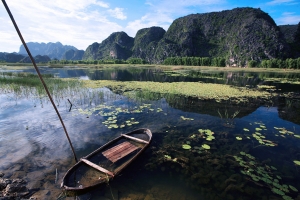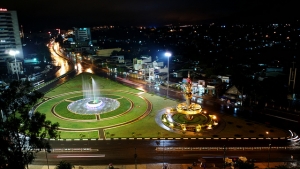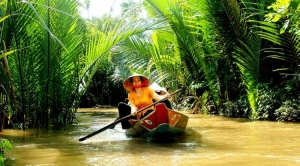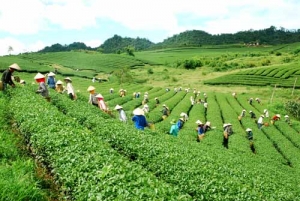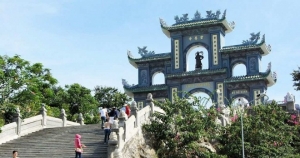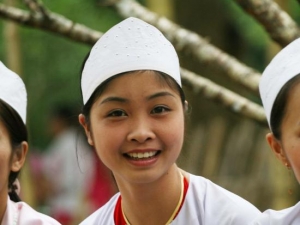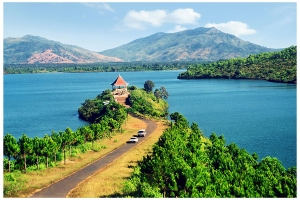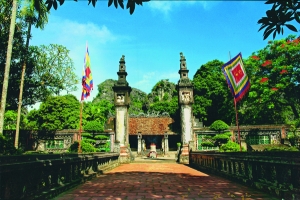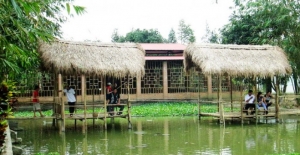
Asia Pacific Travel Team
Van Long Lagoon - One of Ninh Binh's tourism attractions
Located in Gia Vien district, Ninh Binh province, Van Long is the largest wetland preservation area in the Red River Delta

At present, it is one of the province’s tourism attractions in particular, and the country in general

The beauty of Van Long Lagoon has attracted both Vietnamese and international tourists, scientists, photographers and businessmen. Traveling by boat on the lagoon, tourists can see Delacour's lutung drinking water at the mountain foot or expose to the sun on the mountain top

Delacour's lutung, also known as Delacour's langur, is good at climbing. They eat different leaves in jungles
A glimpse of Pleiku (Gia Lai province)
With its foggy atmosphere, wintry evenings and winding roads encircling hills and mountains, Pleiku has the feeling of a beautiful painting.
After a two-day assignment, I had one day to discover this city in the Central Highlands province of Gia Lai.
Waking up early, I opened the window at my hotel and was charmed with the morning sunlight, as well as the fresh air, which carried the scent of morning dew as well as a hint of nocturnal chill.
My friend, Hoang Nguyen, picked me up at the hotel. He promised to introduce me a speciality of the mountainous city, pho kho (dry noodles), named as one of 10 Vietnamese dishes of gastronomic importance to the international community by the Asia Record Organisation (ARO).
He took me to a small food shop on Nguyen Van Troi Street, where we met friendly local Ho Van Quy.
"Pho kho is the most delicious food in Gia Lai. You can see it everywhere, from roadside stalls to luxurious restaurants," Quy said.

Pho kho
Pho kho is also called pho hai to (two-bowl noodle) as the dish is served in two bowls. One contains dry noodle topped with a mixture of fried ground pork, fried onion, raw vegetables like lettuce and bean sprouts and hot chili garlic sauce. The other bowl holds a sweet broth with sliced beef or meatballs.
As Quy said, pho kho was very delicious. I wanted to order one more, but Nguyen said he would take me to have many kinds of food in Pleiku such as lui (skewered grilled pork paste), nem (spring rolls) and thit bo nuong ong (grilled beef in bamboo pipe) so I must stop my gluttony.
Near the pho kho stall, there was a small cafe where tens of locals sat drinking and talking.
"Locals here usually drink coffee in the morning. They don't care to drink in a smart shop. They're just looking for a place to sip coffee and chat with friends. Coffee is a key part of the cultural and spiritual life of Pleiku people," Nguyen explains.
I remembered that one of my friends had said that drinking coffee in Pleiku was the most wonderful experience, so I looked forward to my first cup.
We passed several roads filled with cafes. Wuu, Hai Ba Trung and Le Lai roads are even called "Cafe Streets" because so many coffee shops are packed so close together.
We stopped at Nhac Trinh Cafe, an old-fashioned place on Wuu Street that was very crowded.
"I was born and grew up in Pleiku. My love for this plateau is inseparable from my love for coffee," one local confided.
While I have enjoyed coffee in many regions, the taste of Pleiku coffee and the space overwhelmed by wind, sunshine, pine trees and misty slopes were unforgettable.
About 10km outside of Pleiku is tourist attraction Cong Vien Dong Xanh (Dong Xanh Park), the first water park in the province. There also displays a fossilised tree, which is said to be more than 1 million years old, found at an extinct volcano in neighbouring Ajun Pa District.
Diversions include water slides (only open on weekends) and a zoo that kids might enjoy, along with two ostriches running around in an enclosure near the entrance.
There's also a crocodile pond offering "feeding shows".
From the park, we visited Gia Lai and Ho Chi Minh museums, Yaly Falls and Phu Cuong Waterfall. In the afternoon, we made our way to Minh Thanh Pagoda, one of the biggest and most beautiful pagodas in Pleiku, located on a hill about 2km southwest of the city.

Minh Thanh pagoda
The pagoda draws many tourists thanks to its unique architecture and solemn atmosphere. In the late afternoon sun, the sound of bells can be heard, bringing peace for visitors.
Amazing one-day trip to the Mekong Delta
However, the latest trip with my company’s colleagues to Tien Giang and Ben Tre last week was a great experience to discover the culture and daily life of local people and to build our team-building spirit in just a one-day trip by bus and boat.
From HCMC, travelers can easily take a bus to the Mekong Delta at numerous tourist agencies in the backpacker area of Pham Ngu Lao-De Tham-Bui Vien streets in District 1 or at a bus station on Le Hong Phong Street in District 10. Or they can book a tour with some popular agencies like Saigontourist and Fiditour at the price from VND650,000 per person for a one-day trip, inclusive of meals, drinks, and transportations.
Travelers can also drive their motorbikes for 1.5 hours to explore the location. Tourists are advised to wear simple clothes and sandals to easily move on boats. Sun cream, insect repellent, hats and overcoats are also must-have items.
The first destination of the journey is Tien Giang, about 70km from downtown HCMC. After having breakfast with com tam (broken rice) and hu tiu My Tho (My Tho-styled noodles), tourists will get on a wooden boat at Ba Muoi Thang Tu Wharf to cruise around the Tien River.
Tourists can admire My Tho fishing port and four islets named after four sacred animals of Long (dragon), Lan (unicorn), Qui (turtle) and Phung (phoenix).
The boat will dock at Thoi Son Islet so tourists have time to visit an immense of fruit gardens of nhan (longan), chom chom (rambutan), thanh long (dragon fruit), du du (papaya) and thom (pineapple) and enjoy fresh fruits accompanied by don ca tai tu (traditional music of southern Vietnam) performance by local artists. The southern folk music was acknowledged as the Unesco intangible cultural heritage of humanity earlier this year.

Thoi Son islet
A highlight of the trip is when tourists get on a small boat with a capacity of six people, including two local paddlers to drift along a small canal under the shades of coconut trees. A bustling atmosphere of a hundred of boats hustling in a small channel with the sound of paddles beating the water surface might be an unforgettable moment to tourists. According to a local paddler, thanks to the tourism industry there are 600 people earning their livings from sailing boats. They are paid VND15,000 per person for a boat trip plus tips from travelers.
Leaving the small boat, travelers will be back to the big boat to visit venues that raise bees and make coconut candies. Tourists will be served hot lemonade with honey and eat freshly made coconut candies. There are bottles of honey sold at the price of VND100,000 each. Tourists can also take souvenir photos with a python and bees.
A not-to-be-missed activity is dressing up like a farmer to catch fish in a muddy canal and then enjoy all the caught fish that are grilled in local style together with other rustic dishes like braised pork, canh chua (sour soup cooked with fish) and stirred vegetables for lunch. After the meal, tourists are ready to head to Phung Islet which restores artifacts and properties of Ong Dao Dua or Nguyen Thanh Nam, a founder of Dao Dua religion in Ben Tre Province.
When the sun starts going down on the horizon, it is the time tourists turn back to the city to wrap up a one-day trip to get an insight into daily life of people in the Mekong Delta.
Tea plantations in Moc Chau (Son La province)
Moc Chau, less than 200 kilometers from Ha Noi and more than 1,000 meters above sea level, is now an increasingly popular destination for travelers thanks to the stunning scenery of the northern upland. Moc Chau is also well known for its picturesque fields of flowers of different species that can be found between November and February.
I and my friend arrived in Moc Chau in a summer afternoon after around five hours on a packed bus and the plateau welcomed us with light rain and mild climate. Hearing some locals on the bus telling their stories and suggesting places of interest like what the driver assistant told us such as Dai Yem Waterfall, Doi (Bat) Cave and, of course, tea plantations helped us forget the stuffy atmosphere inside the cramped bus.
Moc Chau has many large tea farms such as those in Nong Truong Moc Chau Town and Tan Lap Commune. Vast green tea plantations seem to have their own attractiveness. Despite having visited a couple of tea plantations in the Central Highlands province of Lam Dong before, I was still impressed by the rolling hills of tea in Moc Chau.

It was also interesting to hear a female farmer I met on the plantation in Nong Truong Moc Chau Town talking about how amazed she was when seeing tea fields in Moc Chau when she moved there more than 10 years ago. “When I first came to Moc Chau, these hills of tea captivated me and I wished to settle down here,” she said.
She also told us to climb up to the highest hill on the plantation with an abandoned water tank on top to have a panoramic view of the entire area and watch vehicles running on the curvy National Highway 6 from afar.
Linh Ung pagoda ( Danang city )

Local residents on Son Tra peninsula recalled stories relating to the existence of the pagoda. Accordingly, under the reign of King Minh Mang in the Nguyen Dynasty in the 19th century, a Buddhist statue drifted downstream to the area and ran aground at a sandy embankment.
Local villagers thought it was a good omen, so they built a small pagoda to worship the statue. From that day on, the whole coastal region enjoyed good weather, with no big storms and rough seas, while local fishermen caught plenty of fish.
The embankment where the statue drifted was then named Bai But, meaning “Buddha’s sanctuary in the real life”, where the present-day Linh Ung Pagoda is located.
The pagoda was built with a perfect harmony of modern and traditional features typical of a Vietnamese pagoda. It has become an attractive tourist site in the beautiful coastal city of Da Nang.
Situated on an area of about 20 hectares on the side of a mountain, the pagoda is a magnificent artwork. It looks to the sea while leaning on a vast primitive forest of Son Tra peninsula.

Guanyin statue
From every corner of Da Nang city, visitors can see the Guanyin statue placed in the pagoda courtyard. It is the highest statue in Vietnam , measuring 67 metres in height and 35 metres in diameter at its base. It is as high as a 30-storey building.
Along the two sides of the path leading to the main chamber are statues of 18 Arhats, each describing different human emotions – joy, anger and sadness, and sculptured skilfully.
The main chamber, the ancestors’ house, hall and monks’ house are all built and arranged magnificently.
Linh Ung Pagoda is not only a religious site, but also a spiritual tourist attraction for visitors to Da Nang.
Wedding ritual of the Muong ( Hoa Binh province )
The wedding ceremony of the Muong has been simplified in recent years but it still echoes the traditional ritual. In the past marriage was arranged by the parents and the children, particularly daughters, had no say in the matter. Now young boys and girls are free to date and choose their partners and marriage is voluntary.
The Muong spend several months, even a year, preparing for a wedding. Bui Van Ban of Dich Giao commune, Tan Lac district, Hoa Binh province, says: "The boy’s family will meet with all relatives to ask for their agreement on the marriage. Then we choose a prestigious man or woman to serve as matchmaker. The matchmaker brings two bottles of wine and a tea bag to the future bride’s family. After receiving the matchmaker the girl’s family holds a family meeting to accept the marriage or not.”

The matchmaker is an important figure who represents the bridegroom’s family in making the proposal and discussing preparations. The Muong maintain the custom of asking for wedding presents. The girl’s family normally expects the boy’s family to give a small buffalo, a basket of round sticky rice cakes with no filling to represent the bride’s virginity, some money as the marriage portion of the bride, about 60 liters of wine, 60 kg of rice, and a quantity of betel leaves and areca nuts.

The matchmaker informs the boy’s family of the girl’s request. If the boy’s family doesn’t agree, the matchmaker can try to negotiate a better deal for them. Bui Van Vien, a prestigious and well-spoken man in Dich Giao commune, is often invited to be a matchmaker. Vien says: “I was a matchmaker for many marriages over the past 20 years. I bring the offering of the boy’s family to the girl’s family and make a marriage proposal. The girl’s family will gather in full numbers to receive the matchmaker and listen to the boy’s family’s ideas. We discuss the wedding time and date and other preparations. I inform the boy’s family of the meeting and the wedding present and re-visit the girl’s family to confirm everything. The matchmaker is responsible for arranging everything smoothly.”
Normally the present is brought to the girl’s family one day prior to the wedding. But for the Muong Bi in Tan Lac district the groom, accompanied by a certain number of men, carries the present to the bride’s family on the wedding day. They are invited to stay to enjoy a meal with the bride’s family while the groom has to return home. Bui Van Ban again: “The wedding present must have betel leaves and areca nuts in addition to pigs, chicken, and some money for the bride.”
After welcoming the bride home, the groom’s family gives gifts to the matchmaker and people accompanying the bride and the groom. The Muong uphold the custom that the bride returns to her parent’s house for a couple of days before living with the groom’s family ever after.
Transquility in Bien Ho ( Gia Lai province )
Bien Ho (sea lake) is a must-see destination for visitors to the Central Highlands province of Gia Lai thanks to its picturesque beauty and serenity.
Locals called Bien Ho as T’Nung Lake that means the sea on a mountain. Tourists can admire the romantic scenery of pine trees along the way to Bien Ho before they enjoy tranquility at the lake. At the lake, they can go fishing, cruise around, try delicious fish dishes and more importantly get moments of peace.
The oval-shaped fresh water lake covers 230 hectares and is 7 kilometers from the center of Pleiku City. The lake, whose depth is from 20 meters to 40 meters, is considered as the most important lake to supply fresh water for residents of the city.
According to scientists, Bien Ho is the mouth of a volcano that has stopped erupting for millions of years.
Dinh Tien Hoang temple ( Ninh Binh province )
King Dinh Tien Hoang was known as a buffalo boy with his favorite game to play mimic battle in a reed field of Hoa Lu, an ancient capital of Vietnam. He defeated 12 generals and became the king of Vietnam in the year of 968. Dinh Tien Hoang named the country as Dai Co Viet and chose Hoa Lu as the capital.
The temple will bring tourists back to the past with many legends about Hoa Lu. It doesn’t boast a majesty exterior but its meditative look accompanied with simple beauty of a village life will be an unforgettable experience for travelers who love to discover the country’s history and nature.
The temple is located in the Trang An Scenic Landscape Complex which was acknowledged as a world heritage site by UNESCO in June 2014.
Ha Long in the mist of autumn
It is such a fanciful and unforgettable scenery for those who enjoy a boat trip around the world heritage site of Halong Bay off the northern coast province of Quang Ninh during autumn days under the mist.


Different shapes of stone islands and caves loom in the thin veil of mist accompanied with the sea breeze, which might give people a feeling of getting lost in heaven. Tourists in that moment can understand the value of a natural heritage that was acknowledged by Unesco in 1994 and 2000
Nhan Tam - An ecoregion in Nha Trang ( Khanh Hoa province )
Nhan Tam, a destination in suburban Nha Trang, can give tourists a peaceful yet romantic experience.
The 15-hectare eco-tourist site is 30km west of the central coast city. It is located in Dien Xuan Commune in Dien Khanh District in Khanh Hoa Province.
From the entrance, tourists can admire a shady pathway with various kinds of flowers. People can relax at blooming squash and luffa trellises. Fruits from these plants will be cooked for guests’ lunch.

There is a 10-hectare fruit garden where people can use a long stick to pick their own fruits, from rambutan, mango, and jackfruit to pomelo and mangosteen.
Cu Van Thanh, owner of the site, said that this land used to be covered by eucalyptus trees and now there have been thousands of aloes wood trees.
There are many games for guests to entertain themselves. Many tourists to the site often show interest in catching fish at canals. Groups of five people will dress up like farmers and bring baskets and long-handle buckets down to a canal to complete their mission of catching at least two catfish. Then, they follow to the next activity of cooking these fish. Each group will be giving cooking utensils and some ingredients like chili, pepper, garlic and onion to prepare the food. Food made by guests will be served together with dishes at the site, including fried jackfruit, boiled vegetables, and grilled chicken.

Guests can take a rest at a swimming pool or enter a bamboo forest to find a place to relax in the sounds of rustling leaves and babbling water from the Cho River nearby. The Cho River which starts from the Central Highlands province of Daklak is 74km long and runs through Nhan Tam eco-tourist site.
Other interesting activities that guests are advised to try are zipline game and sailing. To join in the zipline, people have to pass a hanging bridge at the length of 91 m to get to Chuong Hill. Guests will be equipped with helmets and security belts to slide across the Cho River in 20 seconds.
There is also a house to worship numerous meticulously carved Buddha statues on Chuong Hill. Those who love fishing can come to a fish pond to satisfy their hobby and then enjoy their achievements of numerous kinds of fish at the price of VND90,000 per kilo. People can entertain with a crocodile fishing game at the tourist site as well.
Those who come to Nhan Tam during fruit season will be presented a jackfruit, a kilo of rambutan or a pomelo as a souvenir back home.


